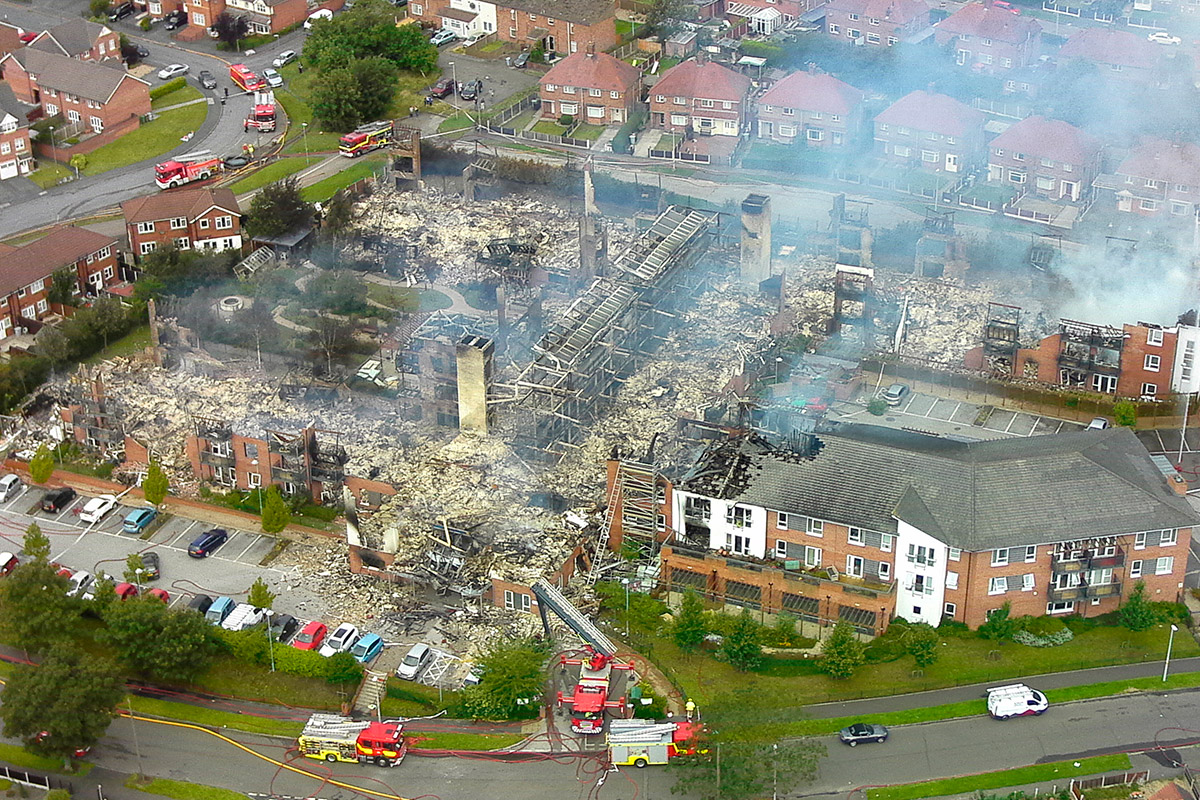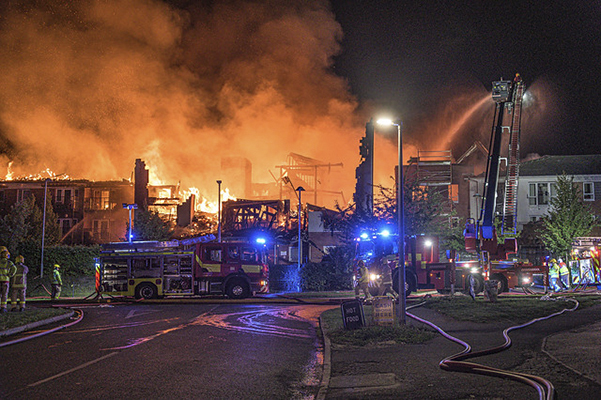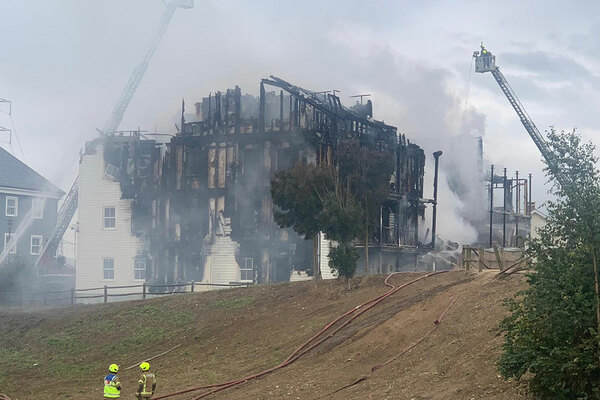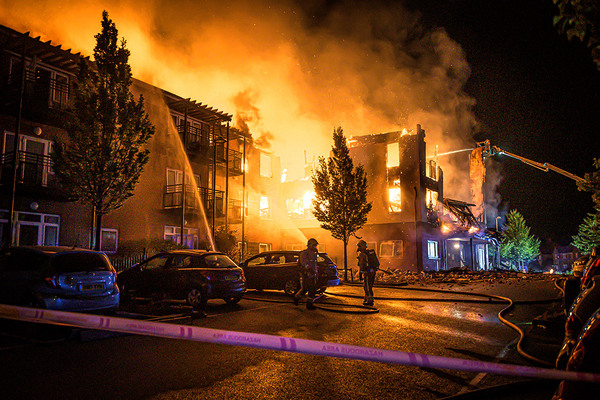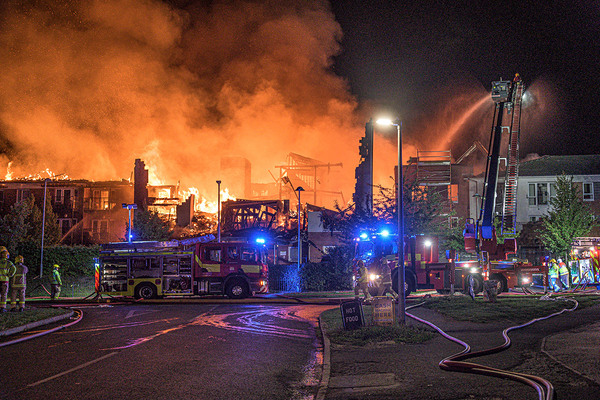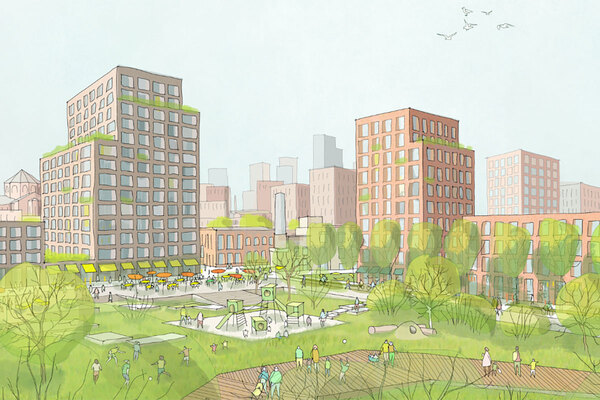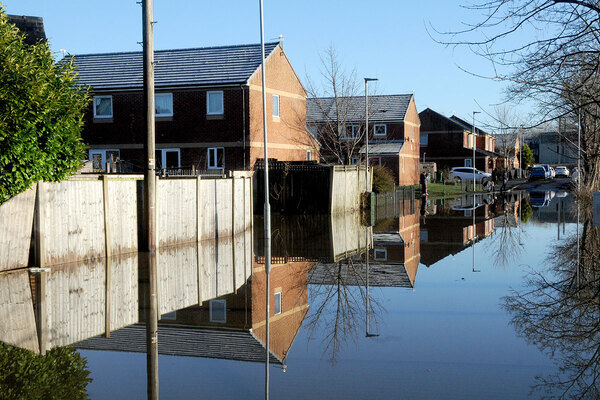Does the Crewe care home fire bring timber frame construction back into the spotlight?
Two weeks ago, a fire ravaged a care home in Crewe. As residents reflect on what they have lost, Lucie Heath looks at what happened and why the spotlight may once again be put on timber frames. Pictures: Cheshire Fire and Rescue Service
“I couldn’t believe how quickly it went up,” recalls Diane Anderson, a 75-year-old resident at the Beechmere retirement complex in Crewe.
Ms Anderson was in her flat with her partner David Jones when the fire alarm went off at around 4.30pm. Aware of the building’s ‘stay put’ policy, the pair sat in their living room for more than half an hour, waiting to be told what to do. It was not until two men ran past their window and shouted at them to get out that they understood the severity of the situation. When the fire service arrived at the scene, a decision was swiftly taken to override the building’s stay put policy and evacuate the building. Lee Shears, head of protection at Cheshire Fire and Rescue Service, later said that this decision “undoubtedly saved lives”.
“The timber frame is the big problem. When fire gets into the cavities there is not much you can do”
Arnold Tarling, surveyor and fire safety expert
Getting out of the building was not easy for Mr Jones. He, like many of the 150 residents at Beechmere, can only move using a walker. By the time the couple got out, the front of the building was already collapsing, Ms Anderson tells Inside Housing.
Firefighters operating 16 fire engines worked throughout the night to tackle the blaze, which started in the roof but spread rapidly.
By the time the fire was finally put out, what was left were largely charred remains. With nowhere else to go, Ms Anderson and her partner spent the night at a nearby dementia care home, and dozens of Beechmere residents were forced to sleep on chairs or mattresses on the floor.
Now, as the dust settles and the investigation into what happened begins, many questions need answering. Among them, how could a fire spread so quickly in a building that was home to 150 vulnerable people?
Opened in 2009, Beechmere retirement complex was one of five built under a private finance initiative contract between Cheshire County Council and developer Avantage – a partnership between housing association Harvest Housing (now Your Housing), MJ Gleeson and Nationwide.
During construction, Avantage told Place North West that 1,700 cubic metres of timber frame had been used and lauded the building as having the largest timber content of any on-site project in Europe.
Avantage has said that all appropriate fire risk and building assessments were in place at Beechmere before the fire, and that it will wait until the investigation concludes to decide whether to review its other buildings. However, local Labour MP Laura Smith has questioned whether the materials used in the building made it inherently unsafe. “Residents want to know and I want to know why vulnerable people were in a building so largely made out of timber… without any sprinklers,” she says.
Fire safety experts have also raised concerns. “The timber frame is the big problem,” says surveyor and fire safety expert Arnold Tarling. “When fire gets into the cavities there is not much you can do. You see it time and again with timber frames where the building is completely lost.”
Architect Sam Webb explains further: “What happens in a timber frame building, if you haven’t got sprinklers, is that you get flashover very quickly.” Flashover is the point at which all combustible materials in a room reach a temperature that causes them to spontaneously ignite. When that occurs, the entire room fills with flames.
But these concerns are not new; there have been questions raised over fire safety in timber-framed buildings for many years. Rewind back to 1999 when a fire test was carried out in an airport hangar in Bedfordshire. It was here at the Building Research Establishment’s (BRE) testing facilities that a government-commissioned fire test on a six-storey, timber-framed block of flats took place.
A fire was started in the structure and successfully put out by the fire brigade in 64 minutes. The test was used to promote the safety credentials of timber frames. However, it later emerged that after the first fire had ended, a second fire broke out in a cavity in the building. According to a 2010 report from the BBC, this second fire was not reported until 2003.
The BRE told Inside Housing that the post-fire report led to a follow-up research project to understand fire risks in combustible cavities.
“When I think about it now and when I see it, I think that building shouldn’t have been built – it wasn’t safe”
Diane Anderson, Beechmere resident
A number of other events since that initial test have heightened fears over the safety of timber frames. In 2002 a major fire broke out at an immigration detention centre in Bedfordshire, just three months after it had opened. The fire resulted in the building being half destroyed and six people being injured. Afterwards it emerged that fire services had previously advised that sprinklers be fitted, partly because of the building’s timber frame. But no sprinklers were ever installed.
Two years later a timber frame structure under construction in Barnet suffered a similar fate when it caught alight. It took 10 minutes for the entire structure to catch fire and 20 minutes to collapse completely. Roughly 2,000 residents were evacuated from their homes and a nearby university halls of residence was severely damaged.
The Barnet fire was the first in a spate of under-construction timber frame fires that plagued the capital. In 2009, 310 people were evacuated from their homes following a blaze in Peckham. A year later, 150 were evacuated from nearby buildings following a fire in Camberwell. Blazes in Hackney and Greenwich brought the total to five major timber frame fires in the capital over a five-year period.
In response, in 2010 the London Assembly launched an investigation into the risk of fires in tall, timber-framed buildings. The report recommended that the government immediately review its building regulations in relation to timber frames. The government rejected the London Assembly’s calls for additional regulation.
Timber frames then re-entered the news in 2015 following two fires in housing association blocks in Wigan and Canterbury. The latter started in an airing cupboard in a building owned by Town & Country Housing Group and spread, consuming five homes and damaging 30.
The fire service said the timber frame meant the fire was “able to spread very quickly among the frame voids”. This prompted local MP Julian Brazier to write to the government calling for an “urgent review” of building guidelines and for sprinklers to be installed in timber-framed buildings.
“If it had occurred at night, local firefighters believe they would have been pulling bodies out of the rubble. We surely cannot allow a fire of this magnitude to happen again,” he wrote.
James Wharton, the minister responsible for building regulations at the time, gave just a two-paragraph response, saying it was “a matter that has been looked into in the past and there are already provisions for [sprinklers’] use in buildings where their use was justified”.
In response to these revelations, a government spokesperson said its recent technical review of Approved Document B had asked for evidence on the provision of sprinklers.
Four years later in Crewe, and the comments from Ms Smith are eerily similar to those in Mr Brazier’s letter. “We were incredibly lucky,” Ms Smith tells Inside Housing. “If it had happened at night-time I think we would have been looking at a different story.”
Like in Canterbury, the residents of Beechmere were lucky to have escaped. However, many have lost their homes and much more.
“She lost all of her possessions – everything,” says the relative of an 83-year-old resident. “All she had was her dog and the clothes on her back.”
Other residents were not so lucky, and many pets were lost in the blaze.
Currently the residents of Beechmere are scattered across Crewe. Some are staying with family, and some, like Ms Anderson and Mr Jones, have been given a temporary place at another extra care scheme. Nobody has told them how long they can expect to stay.
Finding new homes for all 150 residents will not be easy. According to Your Housing, which is working with Cheshire East Council to source alternative accommodation, 34 residents require high care, 50 require medium care and 56 require low care.
Brian Cronin, chief executive of Your Housing, assures that the organisation is putting “every resource available into responding to the crisis”, including putting a mobile office on site to respond to any queries. Yet this is little solace for residents like Ms Anderson, who have lost so much.
Following the fire, the safety of timber-framed buildings, particularly those that house vulnerable people, will be brought into the spotlight.
However, Ms Anderson, who saw the flames completely destroy her home in a matter of hours, is clear about her view on buildings like Beechmere: “When I think about it now and when I see it,” she reflects, “I think that building shouldn’t have been built – it wasn’t safe.”
